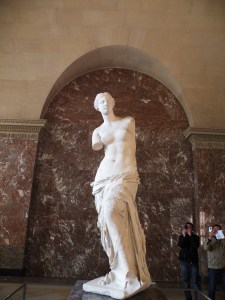Venus of the Louvre by Emma Lazarus

In 1831, Victor Hugo wrote the Hunchback of Notre Dame to help raise funds for the restoration of the Notre Dame Cathedral in Paris, France. Fifty years later, his beloved country would endow the newly United States of America with a gift of friendship, the “Statue of Liberty Enlightening the World”. Following in Hugo’s footsteps, Emma Lazarus, a celebrated American poet, wrote the sonnet, “The New Colossus”, to raise campaign funds in order to build a pedestal for Lady Liberty, with her famous lines now embossed on her pedestal: “Give me your tired, your poor, / Your huddled masses yearning to breathe free” (457). However, many Americans might not know that Emma Lazarus, a prolific professor of English at Princeton, was also a “woman of action; a secular, nationalist Jew” who aspired to emulate Disraeli, Spinoza and Heinrich Heine, a heretic and apostate. (Schor).
Lazarus began writing poetry at an early age and sent some of her works to Ralph Waldo Emerson, who through his generous philanthropy became her literary mentor. She would also be mentored in her short life, dying from cancer at age 38, by Higginson, Stedman, and Burroughs.
After traveling abroad to France and Italy she returned home and included some of her experiences in her poetry such as “Venus of the Louvre”. I was first drawn to this poem to see through Lazarus’s lens the Aphrodite of Milos, an ancient Greek, marble statue created around 100 B.C. and prominently displayed in the Musée du Louvre in Paris, France.
In the first two stanzas of “Venus of the Louvre”, Lazarus pays tribute to this “immortal…foam-borned Mother of Love/…Serenly poised on her world-worshipped throne”, even describing her current physical state of being “transfixed to stone…Times brutal hand maimed but could not mar”(458). Unlike the iconic Mona Lisa who is currently displayed in a large room full of paintings, the Venus de Milo has been exhibited by The Louvre with her very own alcove in the Greek Antiquities wing.
However, the main theme of this poem is not about the Venus statue from Milos, as denoted by the dramatic change of mood in the third stanza with the introduction of a “pale, death stricken Jew/ Her life adorer…Here Heine wept”(458). This is not uncommon for Lazarus as Jewish themes were sometimes present in Lazarus’s poetry as she was a prominent worker for Jewish causes and even organized relief of Russian Jewish refugees in New York after anti-Semitic violence in their home country. Consequently, one would wonder, “who is Heine and why is he weeping/ farewell to love” at the feet of Venus?
According to Lew Fried in his article, “Shall Japeth Dwell in the Tents of Shem? Hellenism and Hebraism in Selected American Jewish Literature”, Lazarus is paying homage through this epigraph to a fellow poet and comrade, Heinrich Heine (40). Heine wrote about his perpetual conflict as a Jew in “The Greek Heine” as he felt a question of alliance between Hebraism, self-conquest and following the will of God, or to Hellenism, a search for truth in nature and reality as the Greeks who tried to follow universal order. The Jewish faith scoffs Hellene as they obey God’s first commandment found in Exodus 20, “You shall have no other gods before me” (NIV). According to Fried, Lazarus stated that ‘“The Greek Heine, a creature of laughter and sunshine” was in conflict with the “somber Hebrew”’ as these Greek idols push the Hebrew God out of the text (42). Heine explained his reaction to seeing Venus in the Louvre:
I took leave of the lovely idols I had worshipped…And when I entered the lofty hall of the Venus, I lay for a long time at her feet and wept so bitterly. Venus looked down upon me compassionately and disconsolately as if to say ‘do you see I have no arms and I cannot help you’. (43 Fried)
In both of her poems,”The New Colossus” and “Venus of the Louvre”, Lazarus gives a beautiful tribute to the sacrifice of religious freedom and the privileges that it brings.
Venus of the Louvre
Down the long hall she glistens like a star, The foam-born mother of Love, transfixed to stone, Yet none the less immortal, breathing on. Time’s brutal hand hath maimed but could not mar. When first the enthralled enchantress from afar Dazzled mine eyes, I saw not her alone, Serenely poised on her world-worshipped throne, As when she guided once her dove-drawn car,— But at her feet a pale, death-stricken Jew, Her life adorer, sobbed farewell to love. Here Heine wept! Here still he weeps anew, Nor ever shall his shadow lift or move, While mourns one ardent heart, one poet-brain, For vanished Hellas and Hebraic pain. by Emma Lazarus (1866)
Copyright 2016 by Robyn Lowrie. May be quoted in part or full with attribution to Robyn Lowrie (www.frenchquest.com)
Works Cited
Fried, Lew. Shall Japeth Dwell in the Tents of Shem? Hellenism and Hebraism. Selected
American Jewish Literature. 29 (2010). Purdue University Press. Web. 10 April 2016.
Hollander, John. American Poetry: The Nineteenth Century.2. New York: Library of
Congress, 1993. Print. 457.
Schor, Esther. Emma Lazarus. Nextbook/ Schocken. Web. 15 April 2016.
